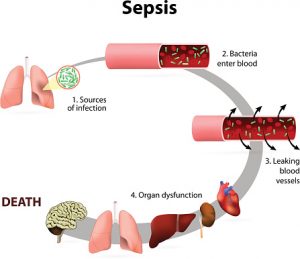
When sepsis progresses to septic shock it triggers severely low blood pressure, which can lead to death.
Sepsis is most commonly found in older adults, although it can affect anyone. If sepsis is treated early with antibiotics, recovery and avoidance of complications is possible.
Bacteremia is the presence of bacteria within the bloodstream. Bacteremia is what can trigger sepsis and body inflammation.
Sepsis vs. septic shock
Sepsis can progress to severe sepsis or septic shock. In severe sepsis, organs begin to malfunction and blood flow becomes reduced. In septic shock, blood pressure levels drop dramatically and even with treatment do not return back to normal.
Severe sepsis and septic shock both occur from the original condition of sepsis. It is complications of sepsis that can lead to severe sepsis or septic shock.
Causes of sepsis

Sepsis is highest among older adults and/or those with a weakened immune system.
Sepsis symptoms
There are three stages of sepsis: sepsis, severe sepsis and septic shock. Each phase of sepsis has its own symptoms.
In sepsis the following symptoms can be seen:
- Body temperature over 101°F (38.3°C) or below 98.8°F (36°C)
- Heart rate over 90 beats per minute
- Respiratory rate over 20 breaths a minute
- Probable or confirmed infection
Symptoms of severe sepsis include:
- Decrease in urine output
- Abrupt changes in mental state
- Decrease in platelet counts
- Difficulty breathing
- Abnormal heart pumping function
- Abdominal pain
The main difference in symptoms between severe sepsis and septic shock is the presence of extremely low blood pressure.
Sepsis treatment
Early treatment is essential to prevent septic shock and other complications of sepsis. Early treatment involves either antibiotics or vasopressors to fight off infection or constrict blood vessels in order to bring up blood pressure. Corticosteroids and insulin may also be used in treatment to stabilize blood sugar and modify the immune system response.
Related Reading:
Sinusitis vertigo and dizziness, a complication of sinus infection
Sinusitis vertigo and dizziness are complications of a sinus infection. Sinusitis is inflammation of the sinuses, which can be caused by bacteria, a virus, or fungus. The sinuses are four hollow cavities in the human skull and are important parts of the immune system as they provide defense against infection. The sinuses are lined with mucous, which expels pollutants and bacteria from the body. Continue reading…
Diabetes is a risk factor for surgical site infections
Research published in Infection Control and Hospital Epidemiology has identified diabetes as a risk factor for surgical site infections. The researchers identified that diabetics have a higher risk of developing surgical site infections (SSIs) than non-diabetics. Continue reading…
Sources:
http://www.mayoclinic.org/diseases-conditions/sepsis/basics/treatment
http://www.merckmanuals.com/home/infections/bacteremia-sepsis-and-septic-shock/sepsis-severe-sepsis-and-septic-shock
http://www.merckmanuals.com/home/infections/bacteremia-sepsis-and-septic-shock/bacteremia